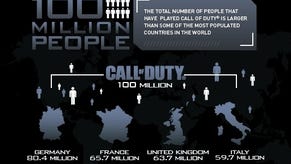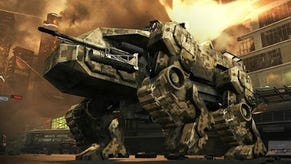Face-Off: Call of Duty: Black Ops
No contest.
| Xbox 360 | PlayStation 3 | |
|---|---|---|
| Disc Size | 6.8GB | 17.9GB |
| Install | 6.8GB (optional) | - |
| Surround Support | Dolby Digital | Dolby Digital, 5.1LPCM,7.1LPCM |
In what is swiftly becoming an annual tradition, Activision's latest Call of Duty looks set to be the biggest launch of the year. Luckily for us, it's also a damn good shooter. What it lacks in innovation it makes up for with a highly polished campaign, the traditionally phenomenal multiplayer modes and a raft of cool bonus additions: split-screen, 3D, zombies, a full hidden game... It's all there. Once dismissed by hardcore players as the "other" COD studio, Treyarch is now a real force to be reckoned with in the FPS genre thanks to World at War and, particularly, Black Ops.
All of this you'll know already, having read the Eurogamer review or perhaps bought the game on launch day. Now's the time for Digital Foundry to step in and take a look at the respective merits of the PlayStation 3 and Xbox 360 versions of the game (we'll be taking a closer look at the PC release this weekend).
Let's kick off with the assets then. This is always the first part of the Face-Off process: capturing the games, synchronising clips, extracting images for the comparison gallery and then editing the head-to-head movie. You might have noticed that we've occasionally posted these assets earlier recently: it gives you a chance to check out the raw elements while we're still poring over them.
First impressions, then. Aside from the gamma difference (which we're inclined to believe emanates from the HANA chip on 360), there is an essential level of parity between the console versions of the game's artwork. Texture difference issues in the COD games should be a thing of the past after Modern Warfare 2, where background data streaming was introduced into the console version of the engine; but while there are some minor texture and tech issues we'll address later, it appears that variations in streaming performance account for most of the minor differences you see in the screenshots.
Both console versions of Black Ops are once again sub-HD. Call of Duty has always been a 60FPS experience - or as close to it as the hardware allows at any given point during gameplay. Infinity Ward made the decision to downscale onscreen resolution in order to create as much temporal resolution as possible - the idea being that a more arcade-style feel to the visuals along with crisper response from the pad would make the game unique. The COD games in the past have hovered around the 1040x600 mark, with 2x multi-sampling anti-aliasing. Combined with quality upscaling, the game still looks the part.
For Black Ops, there have been changes. To the PS3 version at least. The Xbox 360 version remains the same (our measurement comes in at 1040x608 with 2x MSAA) but it appears to be the case that the PS3 game has been reduced to 960x544, again with 2x MSAA. We'll post a movie tomorrow comparing PC running at native 720p to both 360 and PS3 versions so we can see exactly how the resolution cut stacks up, but it's fair to say that while the Xbox game has a slightly cleaner look to it, this isn't really a deal-breaker for PS3 gamers. Black Ops is a good-looking release on both formats.
In previous Call of Duty titles we've seen that the Xbox 360 version of the game produces noticeably superior performance. There was the sense with Modern Warfare 2 that Infinity Ward went for platform parity in terms of the visuals, even if it meant a frame-rate hit on the PlayStation 3 game. However, with Treyarch's last COD title, World at War, there was evidence that the developer wasn't afraid to make some fairly basic, mostly innocuous changes to the visuals in order to close the performance gap.
The challenge facing Treyarch is that the enhancements made for Modern Warfare 2 really seem to have pushed the tech close to the limits, and rather than just tweak the engine for Black Ops there are a number of enhancements: animation (particularly facial animation) is much improved, and skin shaders on the characters are phenomenally good, to the point where the developer is not afraid to use its "actors" as talking heads to relay plot information.
Lighting improvements made in Modern Warfare 2 also appear to have been skilfully deployed in Black Ops, and the developer isn't afraid of tossing around copious amounts of alpha - blending transparent textures traditionally introduces plenty of performance issues. Infinity Ward's last game also allowed for with larger play areas packed with enemies - and there's a definite sense that Treyarch has pushed this further too. So did Treyarch drop the resolution on PS3 in order to close the performance gap?
So let's kick off with two performance analyses. First of all, we'll excise a series of engine-driven cut-scenes from the game. In these pre-defined cinematics, the player is able to look around, but we've left the controller alone - so in theory the engine is rendering effectively identical scenes on both consoles - as good a test as any in determining performance in like-for-like settings.
It's quite telling that the Xbox 360 game drops so few frames throughout most of these cinematics, retaining an advantage even when both consoles are under load. (Update: Due to a read error in the 360 footage, this video has been re-rendered and updated and conclusions slightly altered. The crucial gameplay video below has been verified and stands as is.)
You'll also note some screen tear being registered. This is only present in the PS3 version of the game, and only seems to intrude at the very top of the screen (hopefully tucked away in the overscan area of your display), but is pretty much unnoticeable even if your screen offers a full 1:1 mapping of the resolution. The performance difference is obviously the main concern here. This is all fine in cut-scenes; player interaction is at a minimum and there is no tangible impact to the experience of playing the game. But it doesn't exactly bode well for how the engine is going to cope when it's under extreme stress during gameplay.
Like-for-like footage in a gameplay scenario really isn't possible. All we can do is extract video from the same spots of action being played on both consoles and then watch them to get an indication of the overall run of play.
Performance changes radically in Black Ops depending on what's happening on-screen, but despite this it's rare that the 360 version runs slower than the PS3 game no matter what the context. Indeed, at the very beginning of the video we do have fairly synchronous gameplay, and the difference is telling. In terms of frame-rates, there's no doubt that the Xbox 360 version is significantly smoother overall.
While neither version is locked at 60FPS, there is what we've called in the past a "perceptual 60FPS", where despite the frame-drops you still feel as though you're getting the advantages of the fastest possible frame-rate. There's a fine line in this perceptual divide, but when there can be as much as a 20FPS difference between the two versions, it's safe to say that it's the Xbox 360 version that more consistently delivers the feel of 60FPS gameplay.














